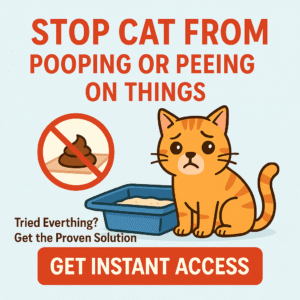Few things are more frustrating for a cat owner than a beloved feline suddenly peeing all over the house—but refusing to use the litter box. If your cat is peeing everywhere but their litter box, it’s not a random act of rebellion. It’s a red flag that something needs your attention—fast.
Why Is My Cat Peeing Everywhere Except the Litter Box?
Cats pee outside the litter box due to health issues, litter box dissatisfaction, stress, or territorial marking. Figuring out the exact reason is the first and most important step to stopping it.
Top Reasons Your Cat Is Avoiding the Litter Box
1. Medical Issues
This is the #1 cause to rule out immediately. Cats in pain or experiencing discomfort during urination may associate that pain with the litter box, leading them to urinate elsewhere.
- UTIs (Urinary Tract Infections): Cause pain, urgency, and frequent urination
- FLUTD (Feline Lower Urinary Tract Disease): Includes bladder inflammation and crystals
- Kidney disease or diabetes: Increase urination frequency
- Arthritis: Makes climbing into high-sided litter boxes painful
Solution: Visit the vet. Medical issues must be treated before any behavior modification can work.
2. Litter Box Problems
Cats are extremely picky about their litter box. A box that smells bad, is placed poorly, or doesn’t feel comfortable can quickly be rejected.
- Litter box isn’t cleaned frequently
- Wrong type of litter (too scented, coarse, or dusty)
- Covered boxes that trap odors
- Box placed in a high-traffic or noisy area
Fix: Use unscented clumping litter, scoop daily, and place boxes in quiet, private areas.
3. Stress or Environmental Change
Cats are creatures of habit. Any disruption in their environment can cause them to act out with inappropriate urination.
- New people, pets, or furniture in the home
- Recent move or home renovations
- Change in feeding schedule or owner absence
Fix: Restore calm using routine, quiet zones, and pheromone diffusers.
4. Territorial Marking
Cats—especially unneutered males—may mark their territory by spraying or peeing in specific areas. It’s a form of communication, not defiance.
- Usually vertical surfaces (walls, doors, corners)
- Triggered by other pets, outdoor cats, or household changes
Fix: Spay/neuter your cat, block outside views, and reduce stress levels at home.
5. Bad Association with the Litter Box
A painful experience (like straining with a UTI or being startled) in the litter box can create negative associations. Your cat may then avoid it altogether.
Fix: Try a different box type or location and reward litter box use with treats or praise.
How to Get Your Cat Back in the Litter Box
Step 1: See the Vet First
Always start by ruling out medical conditions. Your vet may recommend blood work or a urinalysis. Treat any infections, inflammation, or diseases as directed.
Step 2: Clean Accident Spots Thoroughly
- Use enzyme cleaners to remove every trace of urine
- Don’t use ammonia—it smells like urine to cats
- Block access to repeatedly soiled areas temporarily
Step 3: Improve the Litter Box Setup
- 1 litter box per cat, plus one extra
- Place in quiet, low-traffic areas
- Try different litters—unscented, clumping, or soft textures
- Use open boxes for easier access, especially for older cats
Step 4: Reduce Stress and Environmental Triggers
- Use calming pheromones (like Feliway)
- Keep a predictable routine for meals and play
- Provide vertical space and hiding spots for comfort
Step 5: Retrain Behavior with Cat Spray No More
If your cat continues to pee outside the box—even after vet visits and box improvements—you’re dealing with a behavioral issue. That’s when Cat Spray No More becomes essential.
Cat Spray No More: Fix the Behavior for Good
Cat Spray No More is a powerful guide that helps cat owners solve inappropriate urination issues using natural, humane training techniques. It’s designed to address:
- Stress-based and emotional triggers
- Territorial spraying or marking
- Litter box avoidance and habit reversal
- Creating a calm, safe environment your cat actually wants to use
Thousands of owners have turned things around using this easy-to-follow guide—no yelling, chemicals, or guesswork required.
Click here to get Cat Spray No More and finally reclaim your clean, peaceful home.
Quick Reference: Problem & Solution Table
| Problem | Signs | Solution |
|---|---|---|
| Medical issues | Frequent peeing, straining, blood in urine | Vet exam, medication, dietary changes |
| Litter box aversion | Uses floor or soft items, ignores box | Clean box daily, try new litter or location |
| Stress or anxiety | Random peeing, hiding, nervous behavior | Use pheromones, establish routines |
| Marking territory | Spraying vertical surfaces | Spay/neuter, reduce conflict, train behavior |
Final Thoughts
A cat that pees everywhere but the litter box is trying to tell you something. Whether it’s discomfort, anxiety, or confusion, there’s always a reason—and a solution. By addressing health, improving the litter environment, and using positive training tools like Cat Spray No More, you can solve this issue for good.
Don’t just cope—take action. Get Cat Spray No More now and bring peace back to your home—litter box included.
